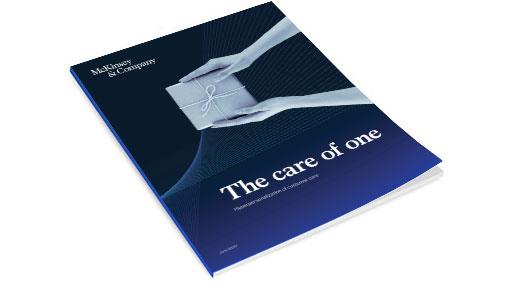Today, organizations and business leaders focus more on customer attention than ever before, because of the distinct advantage it provides in an increasingly competitive landscape. Companies understand that to be successful, they need to attract and retain customers who have ever-easier access to reviews, rankings, and other information that helps them make informed choices.
More are looking to incorporate the newest technologies—often from other sectors—into their changing end-to-end customer journeys: using ride-hailing apps as a model for tracking field personnel, for example, or building virtual try-on experiences popularized by cosmetics companies.
But there’s a downside to this tech-driven pursuit of customer centricity: It can easily turn into a race for the latest “breakthroughs” and tools, regardless of whether they help solve problems in a way that customers will value. However seemingly helpful every shiny and new technology may be, investing in them is not enough transform a company into a truly customer-centric business.
So how can companies become genuinely customer-centric? The experiences of leading customer-experience businesses show that customer centricity starts at the top, with a clear purpose that permeates through every organizational level and activates individuals. This purpose translates into the right structure, product, and services, and only then is reflected in critical enablers such as tools and technology (Exhibit 1).

Indeed, an analysis of countless examples customer-centric transformations reinforce the lesson that this pyramid-shaped process remains essential—and that it holds only when a people-first culture is at the center. Culture is often overlooked, but is a critical foundation in a distinctively customer-centric organization: an organization where all employees collectively and individually prioritize customer needs in everything that they do every day.
Why culture matters in customer centricity
Focusing on culture as a primary means to strengthen customer centricity may seem counterintuitive. But it is employees who interact with customers, hear their concerns first, and observe what delights them before these signals ever form an identifiable, trackable data pattern in a company’s systems. A healthy organizational environment for employees thus directly affects customers.
Examining the relationship between culture and performance uncovered two critical truths.
Culture drives performance. Regardless of industry, healthy companies outperform unhealthy ones by a factor of three. We define “health” as the organization’s ability to align around a common vision, execute against that vision effectively, and renew itself through innovation and creative thinking.
Culture enables successful transformation. People-related activities that reinforce culture are critical to actualize large-scale change. Organizations that tackle them properly increase their odds of a successful transformation by between 30 and 79 percent.
Furthermore, our colleagues’ Organizational Health Index (OHI) research shows that customer-centric organizations activate behaviors that distinguish them from companies with lower net promoter scores (NPSs).
The numbers thus paint a clear picture: in a world where business models are quickly replicated, culture can be the ultimate competitive advantage. Yet “culture” is hardly a managerial formula. Depending on their strategic goals, organizations have many options for shaping a culture that informs behaviors which, in tactical execution, become a distinctive customer experience.
For example, a quick-service restaurant will likely emphasize fast, reliable service, while a high-end hotel focuses on high-touch, personalized interactions. A consumer-electronics company will likely require a very different set of foundational behaviors to meet its sector’s demand for constant, rapid innovation in designing the next market-shaping product.
Yet across industries, our analysis finds that organizations that place customers at the top have a set of behaviors in common, illustrated by the contrast between “hardened hierarchies” whose customer experience and the “empowerment engines” that succeed.
Would you like to learn more about our Operations Practice?
Hardened hierarchies stymie service
Companies that lag behind in customer experience share a common error: failing to put the employee at the center of the equation. Instead, these businesses usually depend on the structure of their customer systems, metrics, and feedback mechanisms to provide the guidance people need. But without much to inspire employees—or in some cases even to equip them to put the customer first—the structure can become more of a hindrance than a help. As a result, these companies’ leaders often struggle to translate their vision and design principles to individual expectations and clear metrics.
Heavy-handed process and reward structures, with little sense of connection to the customer, are common among these organizations. Rather than seek to embed the customer experience in employee behavior, they tend to use centrally gathered customer data to direct employees’ actions in detail. But this top-down hierarchy fails to enable the employee to provide a high-quality experience.
Imagine a call center employee named Sal who has an angry customer on the phone. Sal has a script of predefined answers to common questions in front of him and a screen that tracks how long the call is taking. Data from the company’s customer research shows that shorter wait times are better. Because escalations to managers extend wait times, Sal wants to get this angry customer off the phone quickly.
Sal reads through his canned responses. When these fail to resolve the customer’s issue, he immediately escalates the problem to a more senior team with greater knowledge and access rights. He opens a ticket and transfers the call to the new team. Sal completed the call quickly, which is what his firm has taught him to do. But the customer is now on hold, waiting for the next set of helpers. She’s spending more time and frustration on the problem.
Empowerment engines create experience excellence
Successful customer-centric companies focus on open and transparent communication in the workplace and have leaders who build rapport with their employees. These organizations are driven by supportive leaders who challenge their teams to think differently and creatively, rather than settling for offering subpar service. They push decisions down to frontline associates and have open dialogues on what matters for them, their teams, and the customers.
In this environment, employees have a say on matters that concern them. Companies that inspire employee ownership of solutions cultivate leaders who act as enablers and coaches, putting the right solution frameworks in place, and getting out of the way to let their customer-centric engines run.
The situation Sal faced looks very different for Larry, an employee at an empowerment-engine call center. When a frustrated customer calls, Danny starts by owning the problem. He tries the script he has in front of him, but when the issue remains unresolved, rather than plowing on blindly, he recognizes that the solution won’t be standard. Instead of just kicking the call over to someone else—forcing the customer to wait in yet another queue for help—Danny adds the problem to a shared team chat, asking if others have seen anything like it. One of his colleagues, Gloria, volunteers that she saw the same issue just the other day and comes over to guide him to the solution. The call ends with a satisfied customer.
But Danny is not quite done. He adds the solution to his list for future reference, then submits the issue to a central team to update the script materials so they include the new guidance. At the next shift change, the materials are updated and the shift manager uses Danny and Gloria’s shared experience as a story of customer impact.

The future of customer experience: Personalized, white-glove service for all
Building a customer-centric culture
The comparison between the two call-center employees shows how culture generates customer impact. Developing a customer-centric business culture is a tall effort, but by following a rigorous three-stage process of discover, design, and deliver, companies can help make sure the effort pays lasting rewards.
Discovering what matters for your customers and your people
In the “discover” stage, organizations take a critical eye to their people’s longstanding patterns of behavior, and question which ones support customer centricity—and which ones may impede it. They identify the behaviors that matter most for their business’s customer-experience design, articulating them as principles to guide specific, observable behavior changes in how frontline employees work with customers.
Even more important, for the behaviors that get in the way, leaders probe to find root causes for the mind-sets they’ll want to change. Otherwise, the negative behaviors are far more likely to return once initial excitement about the possibilities of transformation starts to fade. Exhibit 2 provides an overview of mind-sets that sabotage or support customer centricity.

Designing a new culture
The next step is to develop and implement an enterprise-wide effort to reinforce the desired culture, starting with a plan to drive the change, together with major business initiatives to role model and reinforce the new culture.
One company established a customer-experience factory to understand and redesign the full customer experience. It created customer-experience teams, with members from multiple functions, and trained them in agile, design thinking, and problem solving. These teams then worked together to design and deploy solutions—solutions that came from the customer-experience factory and its culture shift toward centering the customer experience—at scale. The company also embedded customer-experience metrics from the start to reward the desired actions and behaviors. In all, the company identified opportunities to improve top-line revenues by 10 to 15 percent and profits by 15 to 20 percent.
Delivering on customer centricity’s promise
With the foundation in place, companies can promote a customer-centric culture that gives employees the support and incentives they need to improve customer experience. Successful organizations typically focus on adapting several areas:
Adjust the work environment to create a coherent employee experience. Employees at Southwest Airlines set workplace norms that influence the day-to-day employee experience: SWA Gratitude (SWAG) allows leaders and customers to recognize employees for great service, including hospitality. Grab, a mobile ride-hailing app, uses the phrase “your problem is my problem” as a core organizational value to guide teams and change mind-sets from “that’s not my job” to “I’ve got your back.” And Lexus approaches customer centricity through its philosophy of “takumi,” which translates to “master craftsperson” and is the highest honor within the organization. People designated as takumi can detect manufacturing flaws that are visible only to the trained eye—a level of precision that come from spending more than 60,000 hours in developing their craft.
Create opportunities for employees to overcome personal barriers more quickly. Often, it’s not as simple as asking employees to behave differently. In one automotive organization, company brass asked dealership managers to talk about customer-service metrics and potential improvements with the sales team every morning. After a few weeks of limited adoption, leaders realized that several managers simply didn’t feel comfortable making formal presentations to their teams. They were concerned that they would lose their colleagues’ respect if the presentations were done poorly. After receiving individual coaching, which included practice presentations, the managers adopted the new model and immediately accelerated and enhanced customer experiences.
Role model and demonstrate clear commitment to the change from the top. For the new culture to take root, senior leaders and managers must model the behaviors and demonstrate their commitment to the customer.
At a European regional bank, leaders set ambitious goals related to customers, performance, and organizational health. The CEO and top leaders made it their personal priority for the company to become the best employer in the region. They actively sponsored and role modeled organizational health across the company, such as by making unannounced visits to the customer-care center where they took phone calls next to regular employees. These actions made it easier for middle managers to drive the change with their teams. The bank became customers’ top choice in its market, while reducing employee turnover by one-third, recording significantly higher earnings, and achieving a double-digit increase in organizational health.
Companies whose culture emphasizes individual responsibility for customer service are likely to improve customer satisfaction, and deliver these results sustainably to improve organizational health and performance along the way. But creating sustainable customer-experience performance means changing company culture at every level.
Getting started means addressing a few questions:
- Where does the organization fall in the continuum between “hardened hierarchy” and “empowerment engine” archetypes?
- What would the organization’s ideal culture look like in two to three years? What behaviors will matter most?
- What cultural barriers or mind-sets may need to change?


